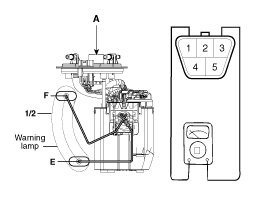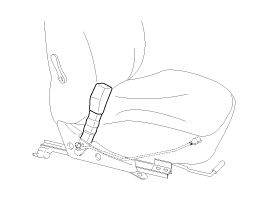 Kia Rio: Instrument Cluster Inspection
Kia Rio: Instrument Cluster Inspection|
| |
 |
|
|
| |
 |
|

| Velocity (km/h) |
20 |
40 |
60 |
80 |
100 |
120 |
| Tolerance (km/h) |
+2.5 +4.5 |
+2.0 +4.4 |
+2.3 +4.9 |
+2.8 +5.8 |
+3.5 +8.5 |
+4.7 +7.7 |
| Velocity (km/h) |
140 |
160 |
180 |
200 |
220 |
- |
| Tolerance (km/h) |
+5.9 +8.9 |
+7.0 +10.0 |
+8.0 +11.0 |
+9.0 +12.0 |
+10.0 +13.0 |
- |
| Velocity (mph) |
20 |
40 |
60 |
80 |
100 |
120 |
140 |
| Tolerance (mph) |
+2.2 +3.6 |
+2.3 +4.3 |
+2.6 +5.0 |
+3.8 +6.6 |
+4.0 +7.0 |
+5.0 +8.2 |
+8.0 +9.4 |
|
| |
 |
|
| Revolution (rpm) |
1,000 |
2,000 |
3,000 |
4,000 |
Remark |
| Tolerance (rpm) |
±100 |
±125 |
±150 |
±170 |
Gasoline |
| Revolution (rpm) |
5,000 |
6,000 |
7,000 |
8,000 |
Remark |
| Tolerance (rpm) |
±200 |
±240 |
±260 |
±260 |
Gasoline |


| Position |
Liter (ℓ) |
gal. |
Resistance (±2Ω) |
| Sender (E) |
2.8 |
0.74 |
200 |
| Warning lamp ON |
5.8 |
1.53 |
170 |
| 1/2 |
22.3 |
5.89 |
66 |
| Sender (F) |
41.8 |
11.04 |
8 |
|
| |
 |
|




| Seat belt condition |
Continuity |
| Fastened |
Non-conductive (∞Ω) |
| Not fastened |
Conductive (Ω) |

| Seat belt condition |
Warning lamp |
| Fastened |
OFF |
| Not fastened |
ON |


 Instrument Cluster Circuit Diagram
Instrument Cluster Circuit Diagram Instrument Cluster Removal
Instrument Cluster RemovalReassembly
1.
Reassemble in the reverse order of disassembly.
•
...
Removal
1.
Remove the under cover.
2.
Remove the mounting nut and disconnect the horn connector, then
remove the horn (A).
...
CVVT (Continuously Variable Valve Timing) System: [CVVT System Mode]
(1) Low Speed / Low Load
(2) Part Load
(3) Low Speed / High Load
(4) High Speed / High Load
...